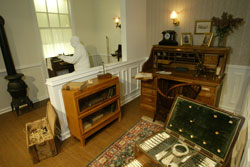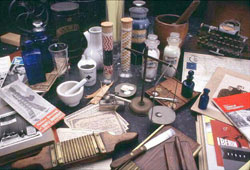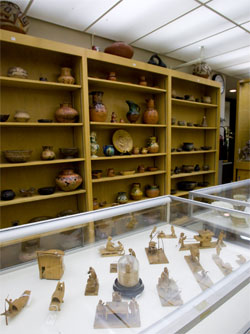Exploring Temple’s lesser-known cultural gems
With concerts and shows at the recently renamed Temple Performing Arts Center, historical artifacts on display in the Blockson Collection and several public exhibits each year at the Tyler School of Art’s Temple Gallery, Temple is fast becoming a cultural destination for Philadelphia and Eastern Pennsylvania. But in addition to these better-known cultural attractions, the university houses several hidden historical collections that offer their own unique treasures.
When the museum opened its doors in 1976, most of the shoes were borrowed for exhibition from a number of sources, including the Philadelphia Museum of Art and the Mütter Museum at the College of Physicians of Philadelphia. The largest collection, later purchased from a shoe manufacturer, includes shoes from around the world.
Many of the shoes are donations from staff, alumni and friends of the podiatry school, including jazz singer Ella Fitzgerald’s gold go-go boots, dress shoes from former president Ronald Reagan and former first lady Nancy Reagan, actress Sally Struthers’ seven-inch blue satin platforms, and sneakers from tennis pro Andre Agassi and basketball great Julius Irving.
“We are one of the largest centers in the United States for the history of foot care,” said Barbara Williams, the museum’s curator. “A lot of foot care has to do with what we put on our feet.”
Opened in 2003, the museum houses some of the oldest and finest dental antiques in the country, including the first-known dental chair in the United States, an original student chair, an antique X-ray machine, dental cabinets and assorted tools, many of which were donated by alumni, students and faculty.
The museum also documents the beginning of American dentistry through three generations of the Flagg family — patriarch Josiah was one of the nation’s first dentists. His grandson, J. Foster Flagg, was a founding member of the Philadelphia Dental College, which became part of Temple University in 1907.
Behind that door is one of the largest collections of pharmaceutical antiques, including wooden drug jars, scales and weights, gold needles, inhalers, and a battlefield first aid kit, as well as rare books and documents.
The museum opened in 1947 under the direction of H. Evert Kendig, the pharmacy school’s fourth dean. Among some of its first artifacts: an elaborately carved waiting counter and matching cabinets from The Old Morgan Pharmacy, the first practice of the Wyeth brothers of Philadelphia, who would later found Wyeth Laboratories.
The collection has grown extensively over the years, mostly due to donations from students, alumni and friends of the pharmacy school. Pieces of the collection are often lent to other exhibitions and for public display and education.
The lab maintains an extensive collection of Cashinahua artifacts from South America, acquired by noted linguistic anthropologist and former Temple professor Ken Kensinger. The artifacts — including belts, necklaces and headdresses — date from the mid-1960s when Kensinger lived among the tribe.
Also of note is a collection of chamber pots excavated on the site of a home in the Society Hill section of Philadelphia where Temple archaeology students have been investigating what was the city’s first almshouse, or home for the poor. Approximately two dozen chamber pots, all from the 1700s, were recovered from what is believed to be the almshouse’s privy.
The most recent acquisition is a diverse collection from what was the Philadelphia Commercial Museum. The Commercial Museum held items exhibited worldwide, including at the 1893 World’s Columbian Exposition in Chicago, the 1900 Exposition Universelle in Paris, and the 1904 Louisiana Purchase Exposition in St. Louis.
When the city of Philadelphia recently dispersed the remainder of the Commercial Museum’s artifacts, various groups and universities were invited to add items to their own collections. Pieces the Anthropology Lab received include African and Asian ceramics, trade and export samples, miniature wood carvings and dioramas.
—Renee Cree, Kim Fischer



